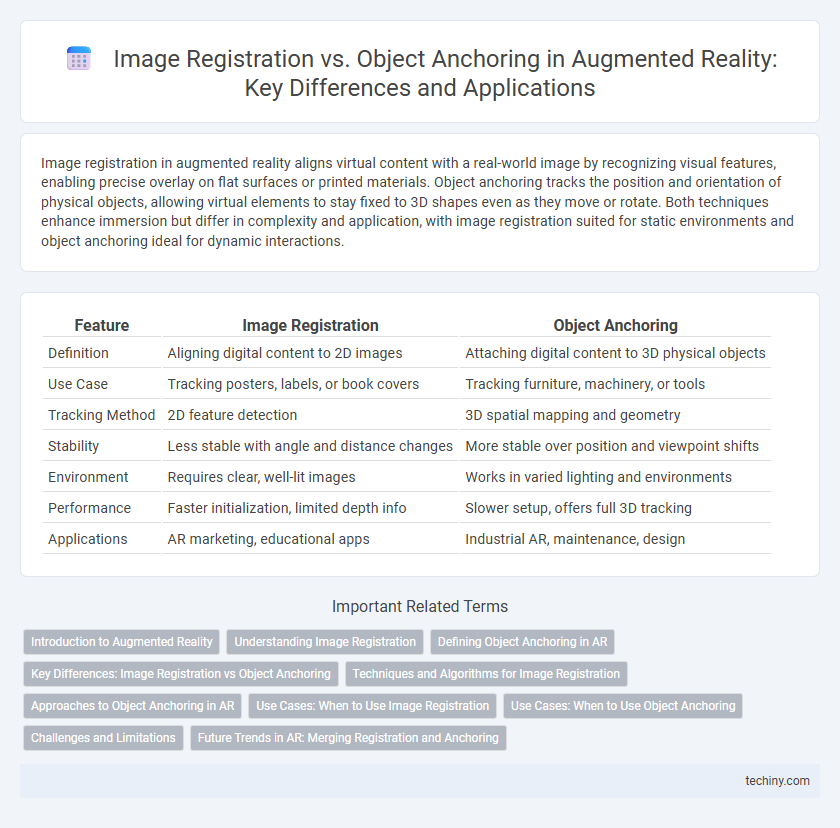Image registration in augmented reality aligns virtual content with a real-world image by recognizing visual features, enabling precise overlay on flat surfaces or printed materials. Object anchoring tracks the position and orientation of physical objects, allowing virtual elements to stay fixed to 3D shapes even as they move or rotate. Both techniques enhance immersion but differ in complexity and application, with image registration suited for static environments and object anchoring ideal for dynamic interactions.
Table of Comparison
| Feature | Image Registration | Object Anchoring |
|---|---|---|
| Definition | Aligning digital content to 2D images | Attaching digital content to 3D physical objects |
| Use Case | Tracking posters, labels, or book covers | Tracking furniture, machinery, or tools |
| Tracking Method | 2D feature detection | 3D spatial mapping and geometry |
| Stability | Less stable with angle and distance changes | More stable over position and viewpoint shifts |
| Environment | Requires clear, well-lit images | Works in varied lighting and environments |
| Performance | Faster initialization, limited depth info | Slower setup, offers full 3D tracking |
| Applications | AR marketing, educational apps | Industrial AR, maintenance, design |
Introduction to Augmented Reality
Image registration aligns digital images with real-world views by matching features and spatial coordinates, enabling accurate overlay in augmented reality (AR). Object anchoring tracks and fixes virtual objects to physical items in real-time, allowing consistent placement as users move. Both techniques are fundamental for seamless AR experiences, enhancing interaction and immersion through precise spatial mapping.
Understanding Image Registration
Image registration in augmented reality involves aligning virtual content accurately over a physical image by detecting and matching key features in real time. This process ensures that digital overlays remain stable and precisely positioned as the user's perspective or device moves. Understanding image registration is crucial for applications requiring precise interaction with printed images, such as AR markers or printed graphics.
Defining Object Anchoring in AR
Object anchoring in augmented reality involves securely attaching virtual content to real-world objects using precise spatial tracking and recognition technologies. This process ensures consistent alignment of digital overlays with physical items, maintaining their position and orientation as the user moves. Unlike image registration, which relies primarily on matching feature points from flat images, object anchoring encompasses three-dimensional tracking for dynamic and complex object integration.
Key Differences: Image Registration vs Object Anchoring
Image Registration in Augmented Reality involves aligning virtual content to a 2D image, using feature points for precise overlay, whereas Object Anchoring tracks 3D physical objects in real space to maintain stable virtual interactions. Image Registration is primarily used for flat targets like posters or products, enabling AR experiences triggered by recognizable patterns, while Object Anchoring supports dynamic, movable objects with depth and spatial orientation. The key difference lies in Image Registration's reliance on 2D feature detection versus Object Anchoring's 3D spatial tracking and pose estimation.
Techniques and Algorithms for Image Registration
Image registration in augmented reality uses feature-based techniques such as Scale-Invariant Feature Transform (SIFT) and Speeded-Up Robust Features (SURF) to detect and match keypoints between real-world images and digital overlays, enabling precise alignment. Algorithms like Iterative Closest Point (ICP) optimize the transformation matrix by minimizing the distance between matched points, improving registration accuracy in dynamic environments. Object anchoring relies more on spatial mapping and persistent coordinate systems, whereas image registration depends heavily on computer vision algorithms for real-time feature extraction and matching.
Approaches to Object Anchoring in AR
Approaches to object anchoring in augmented reality involve precise spatial alignment between virtual content and real-world objects using sensor fusion, feature tracking, and environmental understanding algorithms. Techniques such as marker-based tracking, simultaneous localization and mapping (SLAM), and depth sensing enable persistent and stable virtual object placement, improving user interaction and immersive experiences. Advanced methods integrate machine learning models to enhance robustness in dynamic environments and varied lighting conditions.
Use Cases: When to Use Image Registration
Image registration is ideal for augmented reality applications that require precise alignment of digital content with 2D images, such as product packaging, posters, or magazine pages, where the visual marker is flat and easily recognizable. It excels in scenarios demanding high positional accuracy for overlaying interactive elements on printed materials, making it perfect for marketing campaigns or instructional guides. Image registration is less suitable for environments with dynamic or 3D objects, where object anchoring provides better spatial awareness and stability.
Use Cases: When to Use Object Anchoring
Object Anchoring is ideal for AR applications requiring consistent tracking of real-world physical objects, such as product visualization, interactive retail displays, and industrial maintenance where precise alignment with machinery is critical. Use Object Anchoring when the AR experience must remain stable despite environmental changes or occlusions, ensuring accurate overlay on complex or dynamic items. Image Registration suits scenarios relying on flat surfaces or posters but falls short in environments demanding persistent interaction with 3D objects.
Challenges and Limitations
Image registration in augmented reality faces challenges due to varying lighting conditions, occlusions, and perspective distortions, which can lead to inaccuracies in overlay alignment. Object anchoring struggles with dynamic or deformable objects, causing stability issues and reduced tracking reliability over time. Both techniques are limited by computational constraints and sensor noise that affect real-time performance and user experience.
Future Trends in AR: Merging Registration and Anchoring
Future trends in augmented reality emphasize the seamless integration of image registration and object anchoring to enhance spatial coherence and user interaction. Advances in machine learning and computer vision enable dynamic synchronization between real-world images and virtual objects, improving tracking accuracy and environmental understanding. This convergence facilitates persistent AR experiences across diverse platforms, driving innovation in fields such as remote collaboration, gaming, and industrial applications.
Image Registration vs Object Anchoring Infographic

 techiny.com
techiny.com